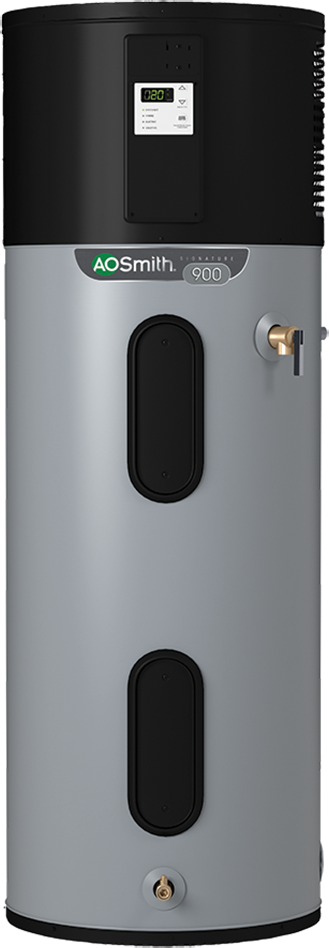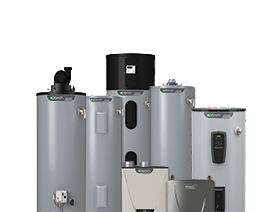The New Generation of Signature Series® Water Heaters
from A. O. Smith
For over a century, A. O. Smith has been a technology innovation leader. That tradition continues to this day
with our Signature Series® water heaters, available exclusively at Lowe's.
A. O. Smith's Signature Series® features a full line of electric, gas, tankless and heat pump water heaters designed to be innovative and efficient without sacrificing value and quality. An A. O. Smith water heater will provide your family with a reliable heating solution for years to come, and that's why we're America's most trusted water heater brand.
NEW Smart Electric Water Heater Technology
Get smarter hot water from A. O. Smith. Now offering A. O. Smith’s smart electric water heaters that can detect, protect and monitor your water heater against leaks giving you ultimate peace of mind.
-
Leak Watch®
Leak Watch® continuously monitors your water heater and alerts you if a leak is detected.
-
Leak Shield®
Leak Shield® automatically shuts off your water supply to protect your home when a leak is detected.
-
iCOMM™ Smart Connectivity
iCOMM™ Smart Connectivity lets you monitor & manage your water heater remotely with the click of a button using the A. O. Smith app.
Signature Series® Products

SIGNATURE® 100 SERIES
Dependable Hot Water
The Signature® 100 Series provides dependable hot water at an affordable cost and a 6-year limited warranty.
Shop 100 Series >

SIGNATURE® 300 SERIES
Smart Water Heaters with Leak Detection
The Signature® 300 Series features smart water heaters with iCOMM™ smart connectivity, Leak Watch® leak detection and a 9-year limited warranty.
Shop 300 Series >

SIGNATURE® 500 SERIES
Smart Water Heaters with Leak Detection & Protection
The Signature® 500 Series features smart water heaters with iCOMM™ smart connectivity, Leak Watch® leak detection, Leak Shield® automatic shut-off and a 12-year limited warranty.
Shop 500 Series >

SIGNATURE® 900 SERIES
Advanced Energy Savings
The Signature® 900 Series heat pump technology is 3X as efficient as standard electric technology-saving you up to $454 per year on your energy bills and a 10-year limited warranty.
Shop 900 Series >
Electric Water Heaters FAQ
-
Electric water heaters use a dip tube to bring cold water into the bottom of the water tank where heating elements heat and keep the water warm. Heated water rises to the top of the tank where it exits and heads to your faucets. Although some standard gas-fueled tank water heaters do not require an electric connection, an electric water heater does require an electric connection.
-
There are several things that can affect the life of your electric water heater, including whether you have hard or soft water in your home and whether you've followed the maintenance schedule recommended by your manufacturer, including routine inspection and replacement when needed of the unit’s anode rod.
-
While electric water heaters can often outlast their warranty depending on use, water quality and maintenance, it's usually a good idea to think about upgrading to a newer model if your water heater is more than 12 years old.
-
Calculations to determine the size of electric water heater you require are the same as those for a gas heater. Calculating the demand at your household's peak usage hour can help you determine how many gallons you typically use in a single peak hour. Once you've determined that number, you'll know what tank size will work for your household. Typically, these guidelines work for most households:
- One to two people: 30 gallons
- Two to three people: 40 gallons
- Three to four people: 50 gallons
-
Whether you're replacing an old electric heater or installing a brand new one, it's important to turn off the electricity at the circuit breaker before you begin, and make sure it's off by testing it with a circuit tester. Always follow the installation manual or consult a Lowe's plumbing contractor when installing your new water heater. While installing your water heater we recommend considering the following:
- Installation or replacement of a drain pan
- Installing or replacing an expansion tank
- Inspect and replace electrical lines
- Make sure your T&P valve is properly drained per your local codes
- Verify that the incoming water pressure is at the recommended pressure per your local codes
ALWAYS READ ALL SAFETY INSTRUCTIONS IN THE INSTALLATION MANUAL CAREFULLY BEFORE INSTALLING













